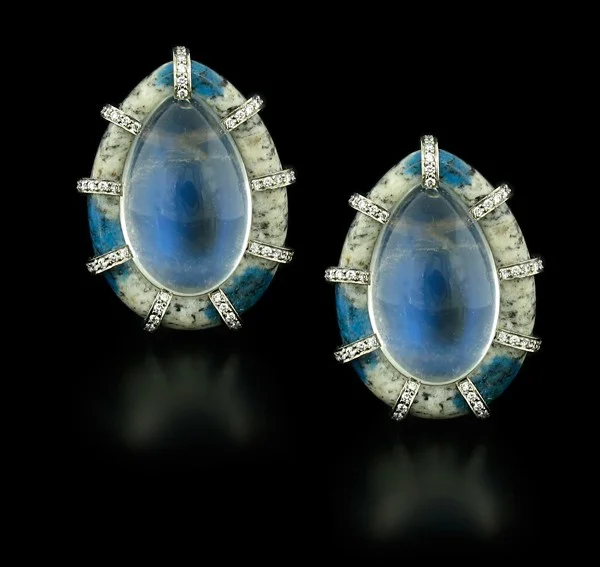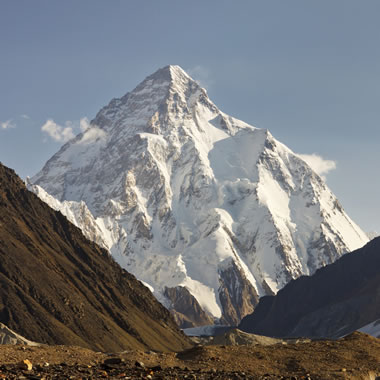Nicholas Varnay and K2
/Nicholas Varney Blue Moonstone and Diamond Earrings: Surrounded by K2, 48 carats Blue Moonstone, 0.60 carats Diamonds. 18K yellow Gold.
A view of K2, also known as Mount Godwin Austen, in the morning sun. With a summit elevation of 8,611 meters, K2 is the second-highest mountain in the world after Mount Everest (8,848 meters), and ahead of Kangchenjunga (8,586 meters). Image © iStockphoto and PatrickPoendl.
One reason I love jewelry by Nicholas Varnay is that he isn't afraid of playing with "unconventional" stones. One of the most interesting is K2 Granite,” also known as “K2 Jasper.”
What is K2 Granite?
"K2 Granite," also known as "K2 Jasper," is an extremely interesting and actually slightly controversial rock and lapidary material that comes from Pakistan.
The mineral is a bright white granite that contains beautifully contrasting orbs of bright blue azurite. The azurite orbs can range from a few millimeters up to about two centimeters in diameter that can look like bright blue splashes on a rough pieces.
K2 Jasper is the most commonly used name for marketing this material, but it is definitely not jasper. If you examine the rock closely you can see that the splotches are actually spherical. You will also see see cleavage faces of feldspar minerals and black flakes of biotite.
The white granite is fine-grained: composed of quartz, white feldspars, and biotite.
The azurite is a secondary material that clearly formed after all of the other minerals in the granite had solidified from the parent melt. This can be seen clearly during an examination of the azurite spheres. They are present along the mineral grain boundaries, within tiny fractures, and as a “dye” penetrating the feldspar grains.
I mentioned that this stone has been slightly controversial. When this mineral first appeared on the market the lapidary world did not believe that the blue splotches could be azurite (and to some extent this is still the case). This is because white granite and azurite rarely occur together. For many this is the first time that they have seen the two materials in such close association.
The Controversy
For the last 3 or so years experienced mineralogists, people from Pakistan who have directly obtained K2 fron it's source, and lapidarists who have worked with K2 cutting cabochons, have had long discussions about the material; sharing observations, photomicrographs, chemical analyses, and x-ray diffraction data trying to learn more about the intrusive mineral, arriving at the conclusion that it is indeed azurite. Some specimens were also found to have small areas that are stained green with malachite! The science of geology continues to evolve and astound!
A piece of dry K2 Granite. A wet surface would increase the intensity of the blue azurite orbs. This piece is approximately 10 centimeters across, and the largest azurite orbs are about 1 centimeter across.
An oval cabochon cut from K2 Granite with several bright blue azurite stains. Within each stain you can see the texture of the granite and grains of black biotite. These indicate that the stain formed after the granite solidified from its parent melt. This cabochon is about 20 x 30 millimeters in size.
Where Is K2 Found?
As stated earlier K2 granite is named after a mountain in the Karakoram Range near the border between Pakistan and China. K2, also known as "Mount Godwin Austen," is the second highest mountain in the world. The azurite granite is found in colluvium near the base of the mountain, in a very remote area visited by very few people.
So What About Using it in Jewelry?
K2 granite cuts, tumbles, and polishes wonderfully. Due to its high feldspar content, it can be easily cut with a lapidary saw and shapes quickly on a diamond wheel. Azurite has a Mohs hardness of 3.5 to 4, however because the azurite is more of a stain within the mother mineral, the dots have the same cutting and polishing properties as the surrounding white granite.
As to the durability in jewelry The feldspar minerals in K2 have a hardness of about 6 on the Mohs scale, therefor they can be be scratched or show signs of wear over time if subjected to extensive use, "hard wear", or impact. K2 is therefore not a good stone for mounting in a ring or bracelet, but it is a sunning (and appropriately safe) addition to the earring that inspired this article.
Kathleen Marino M.A, G.G., AJP, NAJA
A big thanks to geology.com for their extensive research and information on the subject. Another website to visit for more information on the mineralogical makeup of K2 or other minerals is mindat.org


















